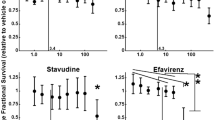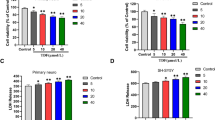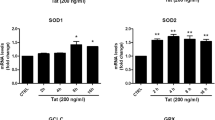Abstract
Mounting evidence suggests that antiretroviral drugs may contribute to the persistence of HIV-associated neurocognitive disorders (HAND), which impact 30%–50% of HIV-infected patients in the post-antiretroviral era. We previously reported that two first generation HIV protease inhibitors, ritonavir and saquinavir, induced oxidative stress, with subsequent neuronal death in vitro, which was reversed by augmentation of the endogenous antioxidant response by monomethyl fumarate. We herein determined whether two newer-generation PIs, darunavir and lopinavir, were deleterious to neurons in vitro. Further, we expanded our assessment to include three integrase strand transfer inhibitors, raltegravir, dolutegravir, and elvitegravir. We found that only lopinavir and elvitegravir were neurotoxic to primary rat neuroglial cultures as determined by the loss of microtubule-associated protein 2 (MAP2). Intriguingly, lopinavir but not elvitegravir led to oxidative stress and induced the endogenous antioxidant response (EAR). Furthermore, neurotoxicity of lopinavir was blocked by pharmacological augmentation of the endogenous antioxidant heme oxygenase-1 (HO-1), expanding our previous finding that protease inhibitor-induced neurotoxicity was mediated by oxidative stress. Conversely, elvitegravir but not lopinavir led to increased eIF2α phosphorylation, indicating the activation of a common adaptive pathway termed the integrated stress response (ISR), and elvitegravir-mediated neurotoxicity was partially alleviated by the ISR inhibitor trans-ISRIB, suggesting ISR as a promoter of elvitegravir-associated neurotoxicity. Overall, we found that neurotoxicity was induced only by a subset of protease inhibitors and integrase strand transfer inhibitors, providing evidence for class- and drug-specific neurotoxic effects of antiretroviral drugs. Future in vivo studies will be critical to confirm the neurotoxicity profiles of these drugs for incorporation of these findings into patient management. The EAR and ISR pathways are potential access points for the development of adjunctive therapies to complement antiretroviral therapies and limit their contribution to HAND persistence.






Similar content being viewed by others
References
Akay C, Lindl KA, Wang Y, White MG, Isaacman-Beck J, Kolson DL, Jordan-Sciutto KL (2011) Site-specific hyperphosphorylation of pRb in HIV-induced neurotoxicity. Mol Cell Neurosci 47:154–165
Akay C, Lindl KA, Shyam N, Nabet B, Goenaga-Vazquez Y, Ruzbarsky J, Wang Y, Kolson DL, Jordan-Sciutto KL (2012) Activation status of integrated stress response pathways in neurones and astrocytes of HIV-associated neurocognitive disorders (HAND) cortex. Neuropathol Appl Neurobiol 38:175–200
Akay C, Cooper M, Odeleye A, Jensen BK, White MG, Vassoler F, Gannon PJ et al (2014) Antiretroviral drugs induce oxidative stress and neuronal damage in the central nervous system. J Neuro-Oncol 20:39–53
Anthonypillai C, Sanderson RN, Gibbs JE, Thomas SA (2004) The distribution of the HIV protease inhibitor, ritonavir, to the brain, cerebrospinal fluid, and choroid plexuses of the Guinea pig. J Pharmacol Exp Ther 308:912–920
Baburamani AA, Ek CJ, Walker DW, Castillo-Melendez M (2012) Vulnerability of the developing brain to hypoxic-ischemic damage: contribution of the cerebral vasculature to injury and repair? Front Physiol 3:424
Bertrand L, Nair M, Toborek M (2016) Solving the blood-brain barrier challenge for the effective treatment of HIV replication in the central nervous system. Curr Pharm Des 22:5477–5486
Blas-Garcia A, Polo M, Alegre F, Funes HA, Martinez E, Apostolova N, Esplugues JV (2014) Lack of mitochondrial toxicity of darunavir, raltegravir and rilpivirine in neurons and hepatocytes: a comparison with efavirenz. J Antimicrob Chemother 69:2995–3000
Borsa M, Ferreira PLC, Petry A, Ferreira LGE, Camargo MM, Bou-Habib DC, Pinto AR (2015) HIV infection and antiretroviral therapy lead to unfolded protein response activation. Virol J 12:77
Brown LA, Jin J, Ferrell D, Sadic E, Obregon D, Smith AJ, Tan J, Giunta B (2014) Efavirenz promotes β-secretase expression and increased Aβ1-40,42 via oxidative stress and reduced microglial phagocytosis: implications for HIV associated neurocognitive disorders (HAND). PLoS One 9:1–9
Caniglia EC, Cain LE, Justice A, Tate J, Logan R, Sabin C, Winston A et al (2014) Antiretroviral penetration into the CNS and incidence of AIDS-defining neurologic conditions. Neurology 83:134–141
Capetti A, Cossu MV, Rizzardini G (2015) Darunavir/cobicistat for the treatment of HIV-1: a new era for compact drugs with high genetic barrier to resistance. Expert Opin Pharmacother 16:2689–2702
Carvalhal A, Gill MJ, Letendre SL, Rachlis A, Bekele T, Raboud J, Burchell A, Rourke SB, HIV/AIDS and the C. for B. H. in (2016) Central nervous system penetration effectiveness of antiretroviral drugs and neuropsychological impairment in the Ontario HIV Treatment Network cohort study. J Neuro-Oncol 22:349–357
Centers for Disease Control and Prevention (2016) HIV Surveillance Report, 2015
Chen J (2014) Heme oxygenase in neuroprotection: from mechanisms to therapeutic implications. Rev Neurosci 25:269–280
Chen MF, Gill AJ, Kolson DL (2014) Neuropathogenesis of HIV-associated neurocognitive disorders. Curr. Opin. HIV AIDS 9:559–564
Cohen RA, Seider TR, Navia B (2015) HIV effects on age-associated neurocognitive dysfunction: premature cognitive aging or neurodegenerative disease? Alzheimers Res Ther 7:37
Cottrell ML, Hadzic T, Kashuba ADM (2013) Clinical pharmacokinetic, pharmacodynamic and drug-interaction profile of the integrase inhibitor dolutegravir. Clin Pharmacokinet 52:981–994
Cross SA, Cook DR, Chi AWS, Vance PJ, Kolson LL, Wong BJ, Jordan-Sciutto KL, Kolson DL (2011) Dimethyl fumarate, an immune modulator and inducer of the antioxidant response, suppresses HIV replication and macrophage-mediated neurotoxicity: a novel candidate for HIV neuroprotection. J Immunol 187:5015–5025
de Boer MGJ, van den Berk GEL, van Holten N, Oryszcyn JE, Dorama W, Moha DA, Brinkman K (2016) Intolerance of dolutegravir-containing combination antiretroviral therapy regimens in real-life clinical practice. AIDS 30:2831–2834
de Gassart A, Bujisic B, Zaffalon L, Decosterd LA, di Micco A, Frera G, Tallant R, Martinon F (2016) An inhibitor of HIV-1 protease modulates constitutive eIF2α dephosphorylation to trigger a specific integrated stress response. Proc Natl Acad Sci U S A 113:E117–E126
Deeks ED (2014) Darunavir: a review of its use in the management of HIV-1 infection. Drugs 74:99–125
Department of Health and Human Services (DHHS) (2016a) Panel on Antiretroviral Guidelines for Adults and Adolescents. Guidelines for the use of antiretroviral agents in HIV-1-infected adults and adolescents. Available at http://www.aidsinfo.nih.gov/ContentFiles/AdultandAdolescentGL.pdf. Accessed 22 August 2017
Department of Health and Human Services (DHHS) (2016b) Panel on Antiretroviral Therapy and Medical Management of HIV-Infected Children. Guidelines for the Use of Antiretroviral Agents in Pediatric HIV Infection. Available at http://aidsinfo.nih.gov/contentfiles/lvguidelines/pediatricguidelines.pdf. Accessed 22 August 2017
Gannon PJ, Akay-Espinoza C, Yee AC, Briand LA, Erickson MA, Gelman BB, Gao Y et al (2017) HIV protease inhibitors Alter amyloid precursor protein processing via β-site amyloid precursor protein cleaving enzyme-1 translational up-regulation. Am J Pathol 187:91–109
Gao X, Wang S, Yang X, Lan W, Chen Z, Chen J, Xie J, Han Y, Pi R, Yang X (2016) Gartanin protects neurons against glutamate-induced cell death in HT22 cells: independence of Nrf-2 but involvement of HO-1 and AMPK. Neurochem Res 41:2267–2277
Gelman BB, Schuenke K (2004) Brain aging in acquired immunodeficiency syndrome: increased ubiquitin-protein conjugate is correlated with decreased synaptic protein but not amyloid plaque accumulation. J Neuro-Oncol 10:98–108
Grant I, Franklin DR, Deutsch R, Woods SP, Vaida F, Ellis RJ, Letendre SL et al (2014) Asymptomatic HIV-associated neurocognitive impairment increases risk for symptomatic decline. Neurology 82:2055–2062
Halliday M, Mallucci GR (2014) Targeting the unfolded protein response in neurodegeneration: a new approach to therapy. Neuropharmacology 76:169–174
Halliday M, Radford H, Sekine Y, Moreno J, Verity N, le Quesne J, Ortori CA et al (2015) Partial restoration of protein synthesis rates by the small molecule ISRIB prevents neurodegeneration without pancreatic toxicity. Cell Death Dis 6:e1672
Hetz C, Mollereau B (2014) Disturbance of endoplasmic reticulum proteostasis in neurodegenerative diseases. Nat Rev Neurosci 15:233–249
Hoffmann C, Welz T, Sabranski M, Kolb M, Wolf E, Stellbrink H-J, Wyen C (2017) Higher rates of neuropsychiatric adverse events leading to dolutegravir discontinuation in women and older patients. HIV Med 18:56–63
Kanters S, Vitoria M, Doherty M, Socias ME, Ford N, Forrest JI, Popoff E et al (2016) Comparative efficacy and safety of first-line antiretroviral therapy for the treatment of HIV infection: a systematic review and network meta-analysis. Lancet HIV 3:e510–e520
Kaul M, Lipton SA (2006) Mechanisms of Neuroimmunity and neurodegeneration associated with HIV-1 infection and AIDS. J NeuroImmune Pharmacol 1:138–151
Kheloufi F, Allemand J, Mokhtari S, Default A (2015) Psychiatric disorders after starting dolutegravir. AIDS 29:1723–1725
Lai DJ, Tarwater PM, Hardy RJ (2006) Measuring the impact of HIV/AIDS, heart disease and malignant neoplasms on life expectancy in the USA from 1987 to 2000. Public Health 120:486–492
Letendre SL, Mills AM, Tashima KT, Thomas DA, Min SS, Chen S, Song IH, Piscitelli SC, extended ING116070 study team (2014) ING116070: a study of the pharmacokinetics and antiviral activity of Dolutegravir in cerebrospinal fluid in HIV-1-infected, antiretroviral therapy-naive subjects. Clin Infect Dis 59:1032–1037
Linden T, Doutheil J, Paschen W (1998) Role of calcium in the activation of erp72 and heme oxygenase-1 expression on depletion of endoplasmic reticulum calcium stores in rat neuronal cell culture. Neurosci Lett 247:103–106
Lindl KA, Akay C, Wang Y, White MG, Jordan-Sciutto KL (2007) Expression of the endoplasmic reticulum stress response marker, BiP, in the central nervous system of HIV-positive individuals. Neuropathol Appl Neurobiol 33:658–669
Lu M-C, Ji J-A, Jiang Z-Y, You Q-D (2016) The Keap1-Nrf2-ARE pathway as a potential preventive and therapeutic target: an update. Med Res Rev 36:924–963
Marra CM, Zhao Y, Clifford DB, Letendre S, Evans S, Henry K, Ellis RJ et al (2009) Impact of combination antiretroviral therapy on cerebrospinal fluid HIV RNA and neurocognitive performance. AIDS 23:1359–1366
Mills AM, Nelson M, Jayaweera D, Ruxrungtham K, Cassetti I, Girard P-M, Workman C et al (2009) Once-daily darunavir/ritonavir vs. lopinavir/ritonavir in treatment-naive, HIV-1-infected patients: 96-week analysis. AIDS 23:1679–1688
Nakagawa S, Castro V, Toborek M (2012) Infection of human pericytes by HIV-1 disrupts the integrity of the blood-brain barrier. J Cell Mol Med 16:2950–2957
Noguera-Julian A, Morén C, Rovira N, Garrabou G, Catalán M, Sánchez E, Cardellach F, Miró Ó, Fortuny C (2015) Decreased mitochondrial function among healthy infants exposed to Antiretrovirals during gestation, delivery and the neonatal period. Pediatr Infect Dis J 34:1349–1354
Podany A. T., Scarsi K. K., Fletcher C. V (2017) Comparative clinical pharmacokinetics and pharmacodynamics of HIV-1 integrase strand transfer inhibitors. Clin Pharmacokinet 56, 25–40
Ramanathan S, Mathias AA, German P, Kearney BP (2011) Clinical pharmacokinetic and Pharmacodynamic profile of the HIV integrase inhibitor Elvitegravir. Clin Pharmacokinet 50:229–244
Robertson K, Liner J, Meeker RB (2012) Antiretroviral neurotoxicity. J Neuro-Oncol 18:388–399
Sacktor N, Skolasky RL, Seaberg E, Munro C, Becker JT, Martin E, Ragin A, Levine A, Miller E (2016) Prevalence of HIV-associated neurocognitive disorders in the multicenter AIDS cohort study. Neurology 86:334–340
Saunders NR, Liddelow SA, Dziegielewska KM (2012) Barrier mechanisms in the developing brain. Front Pharmacol 3:46
Saylor D, Dickens AM, Sacktor N, Haughey N, Slusher B, Pletnikov M, Mankowski JL, Brown A, Volsky DJ, McArthur JC (2016) HIV-associated neurocognitive disorder--pathogenesis and prospects for treatment. Nat Rev Neurol 12:234–248
Schuller DJ, Poulos TL, Wilks A, de Montellano PO (1998) Crystallization of recombinant human heme oxygenase-1. Protein Sci 7:1836–1838
Shah A, Gangwani MR, Chaudhari NS, Glazyrin A (2016) Neurotoxicity in the post-HAART era: caution for the antiretroviral therapeutics. Neurotox Res 30:677–697
Sidrauski C, Acosta-Alvear D, Khoutorsky A, Vedantham P, Hearn BR, Li H, Gamache K et al (2013) Pharmacological brake-release of mRNA translation enhances cognitive memory. elife 2:e00498
Singh MV, Davidson DC, Jackson JW, Singh VB, Silva J, Ramirez SH, Maggirwar SB (2014) Characterization of platelet–monocyte complexes in HIV-1–infected individuals: possible role in HIV-associated Neuroinflammation. J Immunol 192:4674–4684
Singh H, Kaur M, Kakkar AK, Kumar H (2016a) The promise of Dolutegravir: a novel second generation integrase strand transfer inhibitor. Curr Clin Pharmacol 11:88–94
Singh VB, Singh MV, Gorantla S, Poluektova LY, Maggirwar SB, Heaton RK, McArthur JC et al (2016b) Smoothened agonist reduces human immunodeficiency virus type-1-induced blood-brain barrier breakdown in humanized mice. Sci Rep 6:26876
Smurzynski M, Wu K, Letendre S, Robertson K, Bosch RJ, Clifford DB, Evans S, Collier AC, Taylor M, Ellis R (2011) Effects of central nervous system antiretroviral penetration on cognitive functioning in the ALLRT cohort. AIDS 25:357–365
Tan IL, Smith BR, Hammond E, Vornbrock-Roosa H, Creighton J, Selnes O, McArthur JC, Sacktor N (2013) Older individuals with HIV infection have greater memory deficits than younger individuals. J Neuro-Oncol 19:531–536
Teeraananchai S, Kerr S, Amin J, Ruxrungtham K, Law M (2016) Life expectancy of HIV-positive people after starting combination antiretroviral therapy: a meta-analysis. HIV Med 18:256–66
Tiraboschi JM, Knobel H, Imaz A, Villar J, Ferrer E, Saumoy M, González A et al (2015) Cerebrospinal fluid and plasma lopinavir concentrations and viral response in virologically suppressed patients switching to lopinavir/ritonavir monotherapy once daily. Antivir Ther 21:359–363
Treisman GJ, Soudry O (2016) Neuropsychiatric effects of HIV antiviral medications. Drug Saf 39:945–957
Troya J, Bascuñana J (2016) Safety and tolerability: current challenges to antiretroviral therapy for the long-term management of HIV infection. AIDS Rev 18:127–137
UNAIDS (2015) AIDS by the numbers. Available at http://www.unaids.org/sites/default/files/media_asset/AIDS_by_the_numbers_2015_en.pdf. Accessed 22 Aug 2017
Watson RE, Desesso JM, Hurtt ME, Cappon GD (2006) Postnatal growth and morphological development of the brain: a species comparison. Birth Defects Res Part B Dev Reprod Toxicol 77:471–484
Weiß M, Kost B, Renner-Müller I, Wolf E, Mylonas I, Brüning A (2016) Efavirenz causes oxidative stress, endoplasmic reticulum stress, and autophagy in endothelial cells. Cardiovasc Toxicol 16:90–99
Wensing AMJ, van Maarseveen NM, Nijhuis M (2010) Fifteen years of HIV protease inhibitors: raising the barrier to resistance. Antiviral Res 85:59–74
World Health Organization (WHO) (2016a) Consolidated guidelines on the use of antiretroviral drugs for treating and preventing HIV infection: recommendations for a public health approach. Available at http://apps.who.int/iris/bitstream/10665/208825/1/9789241549684_eng.pdf. Accessed 22 Aug 2017
World Health Organization (WHO) (2016b) Progress report 2016. Prevent HIV,test and treat all. Prog. Rep. 2016. Prev. HIV,Test Treat All
Wilcox KS, Buchhalter J, Dichter MA (1994) Properties of inhibitory and excitatory synapses between hippocampal neurons in very low density cultures. Synapse 18:128–151
Yates MS, Tauchi M, Katsuoka F, Flanders KC, Liby KT, Honda T, Gribble GW et al (2007) Pharmacodynamic characterization of chemopreventive triterpenoids as exceptionally potent inducers of Nrf2-regulated genes. Mol Cancer Ther 6:154–162
Yilmaz A, Gisslén M, Spudich S, Lee E, Jayewardene A, Aweeka F, Price RW (2009a) Raltegravir cerebrospinal fluid concentrations in HIV-1 infection. PLoS One 4:e6877
Yilmaz A, Izadkhashti A, Price RW, Mallon PW, de Meulder M, Timmerman P, Gisslén M (2009b) Darunavir concentrations in cerebrospinal fluid and blood in HIV-1–infected individuals. AIDS Res Hum Retrovir 25:457–461
Acknowledgments
We thank Margaret Maronski for her help in the preparation of primary rat cortical neuroglial cultures, Ping Lin for her technical assistance, the NIH AIDS reagent program for their generous donation of ARVs, and Dr. Sarah Ratcliffe for her help with statistical analysis.
Funding
We thank the NIH for the following funding sources: R01MH109382, R01MH106967, R01MH098742 (K.J-S). The following reagents were obtained through the AIDS Reagent Program, Division of AIDS, NIAID, NIH: lopinavir, darunavir, and raltegravir.
Author information
Authors and Affiliations
Corresponding author
Ethics declarations
Grant Support
Financial support was provided by NIH grants MH098742, MH106967, and MH109382.
Ethics Statement
All applicable international, national, and/or institutional guidelines for the care and use of animals were followed. All procedures performed in studies involving animals were in accordance with the ethical standards of the institution or practice at which the studies were conducted. This article does not contain any studies with human participants performed by any of the authors.
Rights and permissions
About this article
Cite this article
Stern, A.L., Lee, R.N., Panvelker, N. et al. Differential Effects of Antiretroviral Drugs on Neurons In Vitro: Roles for Oxidative Stress and Integrated Stress Response. J Neuroimmune Pharmacol 13, 64–76 (2018). https://doi.org/10.1007/s11481-017-9761-6
Received:
Accepted:
Published:
Issue Date:
DOI: https://doi.org/10.1007/s11481-017-9761-6




